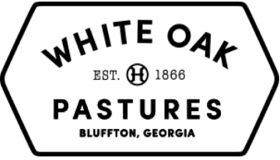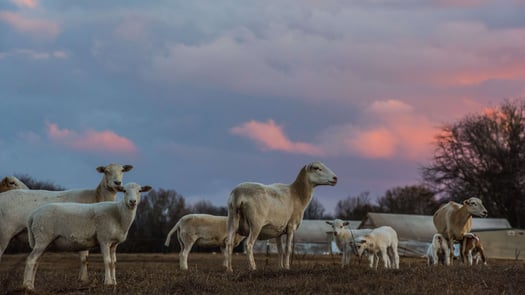
White Oak Pastures now has flocks totalling around 2,000 sheep (up from 200 sheep in July 2019). Our sheep graze everywhere from the forest land bordering our pastures to underneath solar panels.
Our grassfed lamb comes from animals who were raised on pasture, as they were intended to. Most of the lamb available in the United States is raised and slaughtered in other countries. Almost all lamb that is in grocery stores is grain-finished in commercial feedlots.
We provide this side-by-side comparison so that as a conscious consumer, you can make the decision which production model you choose to support.
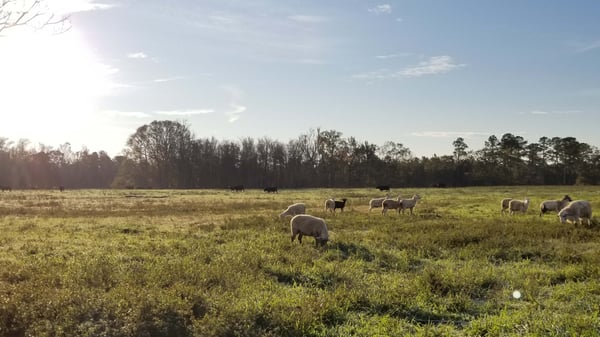
What's the difference between conventional and grassfed lamb?
Conventional sheep are finished in small, confined areas with many other animals in close proximity, which breeds disease. These industrial farmers routinely treat their herds with antibiotics, contributing to making pathogens that are antibiotic-resistant. This renders these otherwise effective drugs to be worthless for treating diseases in humans.
Our sheep are kept in herds on pasture, growing into hardy livestock and developing strong immune systems without the use of hormones and antibiotics.
Conventional sheep are “finished” and fattened on an unnaturally high carbohydrate diet for sheep, eating grains and feed like corn and soy. Since this is not their natural diet (grains are digested faster than the cellulose in grazing forage), these animals can eat more food and gain weight in a shorter period of time. The grain diet is tough on a ruminant’s digestive system, and they become unnaturally obese creatures with issues like ulcers, metabolic disorders, and suppressed immune systems.
Our sheep graze our pastures, because ruminants are meant to eat forage (grass, pasture, hay). Their four-part stomach is designed to break down the cellulose in foraged grasses, allowing them to grow at a natural rate, staying healthy on pasture.
Conventional sheep eat a diet that is not only unnatural for their digestive systems, but is also a product of industrial agriculture production. This feed grain is usually produced using industrial agriculture methods, like pesticides, chemical fertilizers, tillage, and GMOs. Utilization of these practices further degrades soils and our environment.
Our sheep are part of a multi species grazing system, helping us regenerate the soil with their animal impact. We use small ruminants, like sheep and goats, for “targeted grazing” because they love to eat types of forage that cattle don’t prefer. Together, this multi species animal impact helps us regenerate soil and sequester carbon.
Conventional sheep are given antibiotics and synthetic vitamins to promote unnaturally fast fattening.
Our sheep are never treated with antibiotics or steroids, and they gain weight at a natural rate without supplements. Our sheep are Certified Grassfed by the American Grassfed Association, Certified Humane, and Certified EOV by the Savory Institute.
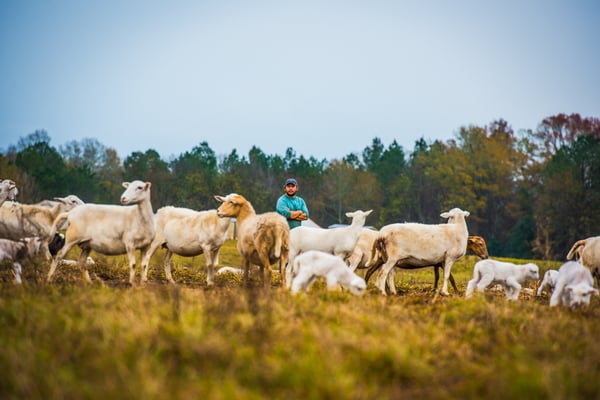
Conventional sheep are fed in a concentrated animal feeding operation (CAFO). They live their life confined in a pen, where their excrement accumulates, having the feed hauled to them.
Our sheep are moved throughout our pastures using herding dogs. We find that there is an instinctual relationship between herding dogs and ruminants, which usually causes a calmer response. Herding dogs also “rate stock”, which means they anticipate what the ruminants will do and help the shepherd move sheep in a low-stress, efficient manner.
Conventional sheep are processed using methods that are a traumatic end-of-life for the animals. They are first packed into large trucks to be transported long distances to centralized meatpacking plants. Most plants rely on mechanized slaughter methods. Sheep carcasses are hung on a mechanical chain for maximum speed of slaughter.
Our sheep are slaughtered and butchered by hand in our on-farm, zero-waste, USDA-inspected processing abattoir. Our sheep do not need to travel long distances to our on-farm processing plant, and our workers move the sheep by hand throughout the plant, running our abattoirs at what we call a humane rate of slaughter. These efforts prioritize the welfare of both our animals and our employees.
Conventional sheep are processed by meatpacking workers who receive low wages and operate in unsafe working conditions. These large, centralized meatpacking plants continue to destabilize our country’s food system and make it more fragile.
Our sheep are processed in our on-farm abattoir, providing local jobs that are kept in our community. These opportunities power rural revival and help create a resilient food system.
Conventional sheep finished in a confined feeding operation leads to meat with lots of dense fat, which may carry a strong, gamey flavor.
Our sheep live on a strictly forage (grass) diet and are very active. By using their muscles to forage and access water, burning calories and fat, the muscle is a leaner, less fatty product. Our customers tend to find our lamb sweeter and milder than commercial feedlot lamb.
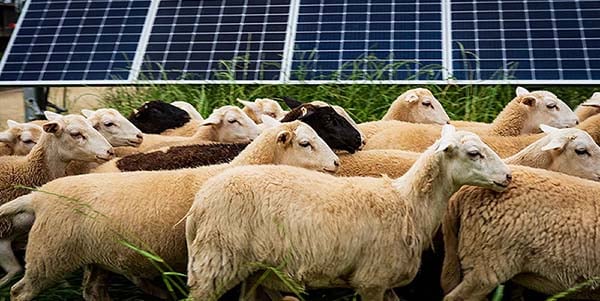
Finally, our sheep play a special role in our farm’s new partnership with Silicon Ranch.
Typically, solar farms manage the land with machinery and herbicide to prevent any shading of the solar arrays. By using sheep, the solar farm can be turned into a carbon sink. This source of energy becomes not just renewable, but regenerative.
